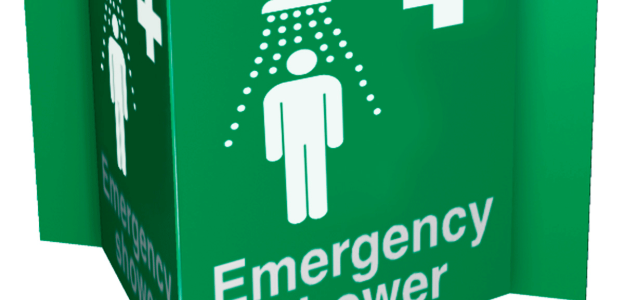
Key Considerations for Emergency Equipment
Eyewash stations and showers must be easy for an injured person to operate and must work reliably whenever they are needed—so the equipment must be tested weekly.
- By Fred Elliott
- May 01, 2015
Why are eyewash systems necessary—can’t employees practice prevention instead? How do I know whether I need an eyewash unit and what kind of unit to purchase?
These questions are frequently asked when the topic of emergency showers and eyewash comes up, sometimes because an OSHA compliance officer has come calling or after a worker has needed emergency medical care because of injury.
Yes, employees who may be exposed to spills, splashes, or debris in their eyes should wear eye and face protection. But an eyewash system also is necessary because the longer caustic substances remain in the eyes, the more damage is done. The answer to the second question is related: If employees work with caustics or acids, the employer must have emergency equipment available and in a readily accessible location.
ANSI/ISEA Z358.1-2014, Emergency Eyewash and Shower Equipment, is the most important U.S. consensus standard for this equipment. Chicago-based Guardian Equipment offers a compliance checklist for the Z358.1-2014 edition of the standard, and the company correctly points out in the document that OSHA's general industry emergency equipment regulation, 29 CFR 1910.151, which covers medical services and first aid, "is quite vague, in that it does not define what constitutes 'suitable facilities' for drenching the eyes or body."
The text of 1910.151(c) simply says this: "Where the eyes or body of any person may be exposed to injurious corrosive materials, suitable facilities for quick drenching or flushing of the eyes and body shall be provided within the work area for immediate emergency use."
It is the Z358.1-2014 standard that puts flesh on these bare bones. It states that water delivered by emergency equipment should be "tepid," that is, between 60 and 100 degrees Fahrenheit, which will not harm the worker who has been injured and will encourage that person to complete the full 15-minute flush during an emergency. The equipment should supply at least the standard's minimum flow rate, which is 20 gallons per minute for drench showers, 0.4 gallons per minute for eyewashes, and 3.0 gallons per minute for eye and face washes.
OSHA’s Eye and Face Protection eTool agrees that quick action in response to an eye injury can prevent a permanent disability. "For this reason," it states:
- Emergency eyewashes should be placed in all hazardous areas.
- First aid instructions should be posted close to potential danger spots.
- Employees must know where the closest eyewash station is and how to get there with restricted vision.
The Z358.1-2014 standard also is generally used as a guide by Canadian employers, according to the Canadian Centre for Occupational Health and Safety.1
Placement Considerations
Another key requirement in the Z358.1-2014 standard that spells out what "immediate" means is that eyewash stations should be placed so they are accessible within 10 seconds’ travel time of places where accidental exposure to chemicals may be expected to occur. There is general agreement that 10 seconds' travel equates to about 55 feet of unobstructed distance from those places in laboratories, maintenance areas, battery charging areas, and storage areas for cleaning products, and the Z358.1-2014 standard says the emergency equipment must be on the same level as the hazard.
Emergency equipment suppliers—including the 10 companies that are members of ISEA's Emergency Eyewash and Shower Product Group—stress that eyewash stations and showers must be easy for an injured person to operate and must work reliably whenever they are needed—so the equipment must be tested weekly.
Highly visible signage should be installed to make the locations of eyewash stations and emergency showers, and the area around these should be well lit. Workers also must be trained on the location and operation of the equipment.
If freezing conditions could arise, the standard specifies that the equipment is to be protected from freezing or that freeze-protected equipment be installed. It’s a best practice to have alarm systems installed on your emergency equipment to alert other employees and summon assistance quickly when an eyewash unit or shower is activated.
Emergency eyewash stations are effective for spills or splashes that are likely to affect only the eyes. Emergency eye/face wash stations are appropriate when a worker's entire face is at risk from spills, splashes, or debris, while drench showers are the best choice when larger areas of the body are at risk. Once a site's potential hazards have been identified, the eyewash and shower needs can be assessed, with the equipment chosen to address the level of exposure to workers and how many workers will be affected.
Emergency Equipment Maintenance Checklist
- Is one individual or department assigned to check all eyewash units and showers once a week?
- Are records kept of the inspections?
- Is the flushing solution checked and replaced when needed?
- Are basins clean and free of trash or debris?
- Is each system tested weekly?
- Are plumbed lines flushed weekly to prevent bacterial or sediment buildup?
- If your contained unit has potable water in it, is the water changed weekly?
- If your contained unit has water with an antimicrobial agent in it, is it changed at least once every six months?
- If your contained unit has a buffered preserved saline solution in it, is it changed every six months?
References
1. http://www.ccohs.ca/oshanswers/safety_haz/emer_showers.html
This article originally appeared in the May 2015 issue of Occupational Health & Safety.